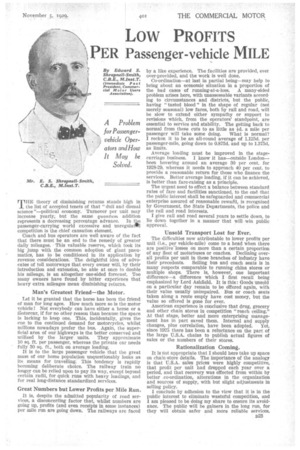LOW PROFITS
Page 121

If you've noticed an error in this article please click here to report it so we can fix it.
\PER Passenger-vehicle MILE THE theory of diminishing returns stands high in the list of accepted tenets of that "dull and dismal science "—political economy. Turnover per unit may increase yearly, but the same quantum addition represents a decreasing percentage advance. In tke passenger-Carrying world excessive and unrcgulatM competition is the chief causation element.
'Coach and bus operators are well aware of the fact that there must be an end to the remedy of greater daily mileages. This valuable reserve, which took its big jump with the common adoption of giant pneumatics, has to be conditioned in its application by revenue considerations. The delightful idea of advocates of toll motorways that every owner will, by their introduction and extension, be able at once to double his mileage, is an altogether one-sided forecast. Too many owners have found by bitter experience that heavy extra mileages mean diminishing returns.
Man's Greatest Friend—the Motor.
Let it be granted that the horse has been the friend of man for long ages. How much more so is the motor vehicle! Not everybody can have either a horse or a motorcar, if for no other reason than because the space is lacking to keep one. This, incidentally, gives the cue to the continued demand for motorcycles, whilst millions nowadays prefer the bus. Again, the superficial area of our highways is the better conserved and utilized by the larger units. They approximate 10 sq. ft. per passenger, whereas the private ear needs fully 30 sq. ft., both on average loading.
It is to the large passenger vehicle that the great mass of our home population unquestionably looks as its means for travelling. This tendency is rapidly becoming deliberate choice. The railway train no longer can be relied upon to pay its way, except beyond certain radii, for quick runs with heavy loadings, and for real long-distance standardized services.
Great Numbers but Lower Profits per Mile Run.
It is, despite the admitted popularity of road services, a disconcerting factor that, whilst numbers are going up, profits (and even receipts in some instances) per mile run are going down. The railways are faced by a like experience. The facilities are provided, ever over-provided, and the work is well done.
Co-ordination—at last in partial being—may help to bring about an economic situation in a proportion of the bad cases of running-at-a-loss. A many-sided problem arises here, with unassessabIe variants according to circumstances and districts, but the public, having "tasted blood" in the shape of regular (not merely seasonal) low fares, both by rail and road, will be slow to extend either sympathy or support to revisions which, from the operators' standpoint, are essential to service and stability. The getting back to normal from these cuts to as little as -id. a mile per passenger will take some doing. What is normal? I reckon it to be an all-round average of 1.125d. per passenger-mile, going down to 0.875d. and up to 1.375d. as limits.
Average loading must be improved in the stagecarriage business. I know it has—outside London— been hovering around an average 30 per cent. for 1928-29, whereas it needs to approach 40 per cent, to provide a reasonable return for those who finance the services. Better average loading, if it can be achieved, is better than fare-raising as a principle.
The urgent need to effect a balance between standard rates of fare and facilities sanctioned, to the end that the public interest shall be safeguarded and commercial enterprise assured of reasonable rewafd, is recognized by Government, the State Departments, the police and the rail and road interests.
I give rail and road several years to settle down, to lie clown together in a manner that will win public approval.
Unsold Transport Lost for Ever.
The difficulties now attributable to lower profits per unit (i.e., per vehicle-mile) come to a head when there are positive losses on more than a certain proportion of any fleet of motorbuses or coaches. Declining overall profits per unit in these branches of industry have their precedents. Selling bus and coach seats is in many respects comparable to running china stores or multiple shops. There is, however, one important difference—a difference which I first recall being emphasized by Lord Ashfield. It is this: Goods unsold on a particular day remain to be offered again, with their value usually unimpaired. Bus or coach seats taken along a route empty have cost money, but the value so offered is gone for ever.
American experience is conclusive that drug, grocery and other chain stores in competition "reach ceiling." At that stage, better and more enterprising management has in part saved them. Internal and supply changes, plus correlation, have been adopted. Yet, since 1925 there has been a reluctance on the part of the large U.S.A. chains to publish actual figures of sales or the numbers of their stores.
Rationalization Coming.
It is not appropriate that I should here take up space on chain-store details. The importance of the analogy is that U.S.A. sales prices were highly competitive, that profit per unit had dropped each year over a period, and that recovery was effected from within by better .co-ordination, alterations in the organization and sources of supply, with but slight adjustments in selling policy.
I conclude by adhesion to the view that it is in the public interest to eliminate wasteful competition, and I am pleased to be doing my share to ensure its avoidance. The public will be gainers in the long run, for they will obtain safer and more reliable services.




































































































































































































































































